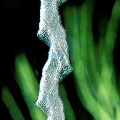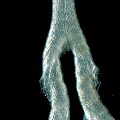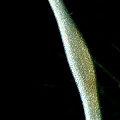Q: Genlisea: the corkscrew plants
A: This is the quintessential lobster-pot genus, taking advantage of a strategy also
referred to as an eel-trap. What do those names
mean, the more urban of you might ask? One of the most effective ways to capture exceedingly edible
lobsters and eels is to create a kind of container that attracts the critter into its interior; once inside, the critter
cannot find its way out. The difference between this and a pitfall trap is that in a pitfall trap
gravity is the primary obstacle that prevents
the animals escape. The primary obstacles in lobster-pots are physical deterrents and elements of misdirection.
The genus Genlisea consists of plants that
grow in very wet habitats, and like the closely related Utricularia they produce their traps
underwater or in water-saturated muck. The top part of the trap consists of a descending stolon. About midway down the
stolon there is a
swollen digestion chamber--the utricle (see photo)--which
makes the descending part of the stolon look somewhat like the neck of an ostrich that has eaten an overly
big lump of food. Below this chamber, the stolon continues downward as a hollow
tube. The tube bifurcates (see photo) into two long, spiralling branches. Each branch
is spirally-slit along its length. Intricate, curved hairs ensure that creatures passing through the slit find themselves in a
tunnel travelling upwards, but are unable to backtrack to freedom. All they can do is progress is towards the utricle.
The traps are easily seen in some aquatic species, while in terrestrial species the traps are hidden in the mucky ground.
Proof of enzyme production in the utricle was provided by Heslop-Harrison in 1975 for G. africana, and
subsequent observations by other scientists demonstrated nutrient uptake using radioisotope-labeling. Very slick!
There are about thirty species in this genus, and there is a great deal that we don't understand about them. Many species produce
two types of traps on the same plant--smaller ones confined to near the soil surface, and much
larger ones that penetrate deeply into the soil. Are the two traps foraging for different kinds of prey? Other observations have found that the tube of
Genlisea hispidula traps have some kind of mucus plug between the utricle and the trap fork.
Some researchers have suggested that prey may be
attracted to the traps, perhaps because of air trapped in the traps. There is some evidence that indicates
Genlisea is particularly effective at trapping protozoans, although poking around in a trap with a
microscope reveals many other prey items, too.
I did some work a long time ago supporting the idea
that it is possible that Genlisea traps may be active, and constantly draw fluid through the traps by
pumping water out of the utricle, through the utricle walls.
There is more recent evidence that this is may be the case, but more work must be done.
I know of no common name for these plants, but some growers call them "corkscrew plants." The Latin genus name honors
Contesse Stéphanie-Félicité du Crest de Saint-Aubin de Genlis, a French writer and educator whose
achievements exceed even the length of her name.
Genlisea cannot be reliably classified by a simple set of characteristics. The great expert Peter Taylor
ultimately concluded that a mix of characters must be used, including the way the flower pedicels bend when in fruit,
the nature of the indumentum (the
hairy surface that covers the plant), and other more minor details. Genlisea identification is
not for the weak-kneed. A dissecting microscope is required to do it properly.
Page citations: Adamec, L. 2003; Barthlott, W., et al. 1998;
Barthlott, W. et al. 2007; Darnowski, D. & Fritz, S. 2010;
Fischer, E. et al., 2000; Fleischmann, A. 2012; Fleischmann, A. et al. 2011;
Juniper, B.E. et al., 1989; Rice, B.A. 1994c, 2006a; Schlauer, J. 2002; Studnicka, M. 2003a; Taylor, P. 1991a.


